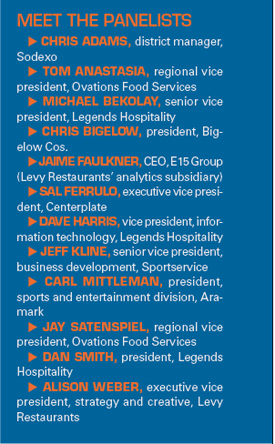We checked in with executives in the concessions industry to get their take on trends they are watching, the future of mobile ordering, and what improvements would be on their “wish list” for sports facilities. Here are highlights of what they told SportsBusiness Journal’s David Broughton. Comments were gathered through direct interviews and via email.
What trends are you watching in concessions?
■ CARL MITTLEMAN, ARAMARK: Food and beverage continues to take on an increasingly important role in
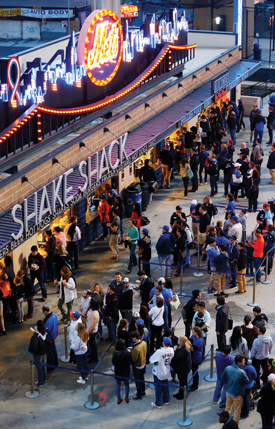 |
Fans line up at the Shake Shack at Citi Field.
Photo by: Getty Images |
the overall fan environment, and customizing those experiences with offerings — whether it is through mobile technology, more diverse fare or flexible dining concepts — will further engage fans. In order to accomplish any of this, first and foremost of importance is understanding the fan, and this is all driven by analyzing data. Among beverage trends, the popularity of craft beer and spirits continues to grow, and fans are looking for these options in general concessions. From a health and wellness perspective, there is a concerted effort to make healthier fare more widely available and accessible to fans. Hot dogs, peanuts and pretzels will still be the best-selling items, but it’s important to provide offerings for fans with special diets, food allergies and other dietary preferences.
■ JEFF KLINE, SPORTSERVICE: We continue to increase the use of local partners; fresh and visible preparation of food choices. We are extremely focused on service and delivery methods.
■ SAL FERRULO, CENTERPLATE: The rise in the “social” experience. I’m not just talking about Instagramming your friends and food, but I’m seeing changes in the way that fans interact, and the number of people who come together at games. So, dining is obviously a natural social connector — trying new things, defining menu items that put a stadium on the bucket list, and offering formats that allow for sampling and sharing are all key. At the suite level in Levi’s Stadium, there are communal tables, so you can have food inside the suite, or you can go outside and be a part of something new and more connected. Club Liv at Sun Life (Stadium) is really an extension of the high-energy Miami Beach nightlife, right in the stadium. In both cases, the shift toward a social experience adds value to game day.
Local sourcing has been a trend for awhile, but we’ve really committed to building local partnerships — not just with farmers and suppliers, but with vendors and brands that grew up in the area. … Finally, there’s a real trend toward authenticity and heritage recipes: comfort foods, simple “clean” preparations (which may or may not be healthy) and house-made recipes.
■ TOM ANASTASIA, OVATIONS: The fresh/crafted trend has permeated both food and drink. After the wine boom subsided, we saw the explosion of craft beers. The new fresh and local creations brought bold new flavors to suit every palate. On the heels of the craft beer wave, we have seen cocktails jump into the limelight. New recipes with fresh ingredients such as herbs, fresh-squeezed juices and in-house infused alcohol help create bold flavored drinks.
Also, the utilization of food and beverage to drive social media content. When possible, we like to work in concert with our clients to keep the food and beverage relevant in their communication with their guests.
■ CHRIS ADAMS, SODEXO: We’re seeing a move to more local fresh flavors and gourmet menu selections and less of the traditional concessions menus. Menu items that appear fresh, made to order and offer choices of selections such as “build your own” selections. Also the ability to market the chef, as in celebrity partnerships, is steadily increasing. The demand from facilities for the public relations opportunity to set themselves above their competitors by being linked to a well-known celebrity chef is constantly being focused on.
■ DAN SMITH, LEGENDS HOSPITALITY: It certainly seems like local, sustainable and organic/hormone free are becoming bigger parts of the conversation. For example, at Prudential Center we have a very robust program that celebrates New Jersey that has really resonated with fans. There, we have partnered with Jersey-born chefs such as David Burke and Mike Isabella and re-created Jersey mainstays such as the Diner and Jersey Shore Boardwalk, featuring respective food experiences. For the Sacramento Kings’ new arena [scheduled to open in 2016], we are working closely with the team to develop a food and beverage program that sources 90 percent of the products from a 150-mile radius. It is at the very core of who they are as a community and for us, we believe that needs to be properly represented in everything we do in the new venue.
■ ALISON WEBER, LEVY RESTAURANTS: Younger generations value time, and controlling their experiences within entertainment venues, leading to development of do-it-yourself serving options to optimize time spent away from the game. We partnered with Barclays Center and 2014 global bartending champion Charles Joly to crowdsource a new cocktail from local Brooklyn mixologists and have introduced Joly’s ready-to-serve, small-batch Crafthouse Cocktails at a number of arenas. Also, do-it-yourself beverage technology, like robotic bartenders and mobile self-serve taps, will make craft and local beverage service more convenient and secure.
■ CHRIS BIGELOW, BIGELOW COS.: The best trend is sports franchises really care about the customer experience and are at least talking with their food service departments on how they can improve menus and service. Also, when I go to an event and wait too long in line, and I observe untrained staff with no back-up help, and then I go to the condiment stand to find it empty or dirty, or both, I just wish concessionaires would spend more time invested in the day-to-day implementations of operations than worried about marketing ideas and big data.
Has mobile ordering and/or mobile payments turned the corner for fans and operators?
■ MITTLEMAN: The past several years were spent investing in the infrastructure to ensure venues can support
 |
Mobile payments and ordering has been slow to catch on, but improved infrastructure at facilities could jump-start the use.
Photo by: Orlando Magic |
mobile technology. For the most part, that has been accomplished. We’re now in the implementation phase. With so many mobile applications and programs being developed and introduced to the marketplace, the challenge is to identify those that present the greatest opportunities. Once those are identified, the next step is to determine how best to monetize mobile technology to ensure there is a viable return on investment.
■ KLINE: It’s a process. And it’s a balance on understanding the venue infrastructure and technical landscape with the acceptance, understanding and adoption of the fans. It has to be fast, efficient and easy to understand.
■ FERRULO: In terms of proliferation, I’d say we’re approaching the corner, and maybe peeking around it. It’s definitely still growing and is bringing greater value to the fan experience. Obviously the 49ers and the Dolphins have made great strides in this area, and the key is connectivity within the building. We have found that clubs and suites really outperform in mobile and attendant-assisted, tablet-based ordering, because you’re in the middle of a social experience and don’t necessarily want to break up the group — maybe because you’re with friends and family, or you’re entertaining clients. But some people are still going to want to browse, and as stadiums get more attractive and comfortable on the concourses, it becomes part of the experience. We definitely see that in venues like AT&T Park and Safeco Field, where the baseball fans are into a “destination” approach to concessions.
■ ANASTASIA: In all of our efforts to offer mobile ordering, the adoption rate by fans has been on average less than 2 percent. Now that more smartphones are enabled with the ability to support tap and pay, we are looking to make a run at testing the viability of this solution in venues.
■ ADAMS: On the operator side you see a delay in catching up with the trends due to the availability of compatible systems. Many venues are lagging behind in the technology upgrades, both in register systems and facility connectivity capabilities, to keep up with these trends effectively.
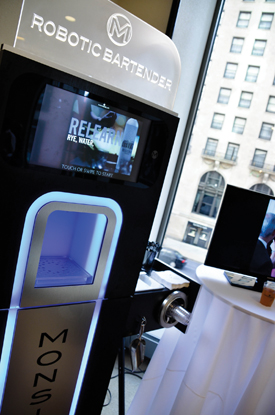 |
Do-it-yourself beverage technology is providing convenience for consumers.
Photo by: Levy Restaurants |
■ JAIME FAULKNER, E15: Mobile ordering and mobile payment technology are poised to take off in 2015. We just helped launch Apple Pay at Amway Center and are starting to see adoption in other arenas, too. Mobile tablet ordering will help teams both create a more seamless guest experience and provide an outlet to capture valuable data on fan preferences, which they can use to better tailor service.
■ DAVE HARRIS, LEGENDS HOSPITALITY: It is by far the fastest-moving part of the industry. The key to changing fan attitude and behavior toward mobile/self-service technology is convenience and adding value. Both are paramount propositions to increasing adoption rates. As Wi-Fi and [distributed antenna system] infrastructure capabilities continue to grow in stadiums and arenas, it will also allow for implementation to get easier. At the end of the day, that has to be in place in order for the experience to be adopted. But the behavior of getting up and going to a concession stand is also part of the venue experience for many and it will take time (and incentive) to change that. Most self-service technologies have needed an incentive to drive widespread adoption and that’s taken multiple years. The same will be the case in venues.
■ BIGELOW: Mobile ordering has been around for over 15 years. I was speaking to Robert Showghi, who was the pioneer in the industry with Dial4Snax [and now with MobileServ Technologies], we realized the adoption rate may have actually decreased over the years. No one knows for sure, but my guesses include poor connectivity in venues, additional costs added to concession prices. My favored opinion is it is not comfortable to eat in a stadium seat; I would rather get up, stretch my legs and visit all of the new dining concepts offered on the concourse and in clubs.
What do you see developing in retail and merchandise?
■ MITTLEMAN: Much like on the [food and beverage] front, customization and convenience will rule the day. Offering apparel and other souvenirs that appeal to the changing demographics of fans has always been important, but probably more so in today’s climate. For example, for Super Bowl XLIX at the NFL Shop at NFL [Experience], which we operated, there was a large part of the store dedicated to women and tweens to account for those growing fan segments.
■ KLINE: Continued increase of choices, ease in ordering and delivery, and more opportunities to equip the fan before, during and after their favorite event.
■ FERRULO: In terms of merchandise, there’s no doubt that women and millennial fans are driving purchases,
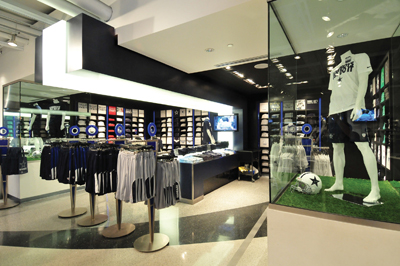 |
When it comes to retail, fans want more choices and the ability to customize their orders.
Photo by: Legends Hospitality |
particularly in apparel, across all of the leagues. We have a proliferation of what I’ll call “lifestyle” gear for almost everyone in the family — this is stuff that you wear beyond game day, and extends to babies, pets, even housewares. And certainly really fun conversation pieces — I love the ugly Christmas sweaters.
■ JAY SATENSPIEL, OVATIONS: The sports franchises have grown their fan bases in the area of women and children, and the demand for merchandise for these two groups has increased as well. Manufacturers have been continuing to expand their availability in styles and sizes created specifically for these groups. Our stores continue to make more room for display of these items. The other area of growth is the manufacture of venue-specific items. Many times the margins required in a venue are such that a fan can buy the same item outside the venue at a reduced price. When the venue creates an item, it allows for better control of the item cost as well as creates an item that the fan can only purchase in venue.
■ ADAMS: For merchandise I see a large opportunity in an in-seat service model, allowing guests to order directly from their phones for items to be delivered or an express pick up, reducing the front-of-house space needed for merchandise store fronts. On the retail side, coming up with interchangeable mobile carts, which can easily swap out or accommodate varying menus and smaller concourse spaces, is necessary as speed of service is always a priority. Added points of sale reduce line times while maintaining a strong variety of options.
■ WEBER: The rise of “athleisure,” blending performance and lifestyle wear, influences team merchandise. New fabrics, cuts, customization and street styling are rising trends in retail. Fans are looking for more customized merchandise. Blackhawks fans, for example, can use our automated kiosk at United Center to get a jersey with their name sewn on in a manner of minutes. Our recently launched Levy Retail Group is working with the Arizona D-Backs to reconcept Chase Field’s flagship team store based on these themes.
■ MICHAEL BEKOLAY, LEGENDS HOSPITALITY: The whole retail experience has been quite static in the industry for some time. But we see a shift in that to the norm becoming more of a personal experience, more of a walk-in, customized, touch and feel, Apple Store-like customer experience. These are helping to elevate shopping at events to a more legitimate, unique (and sometimes personal) experience that is much more aligned to a normal retail operation.
If space were abundant, what would you like to add to your venue?
■ MITTLEMAN: Each venue is unique and these decisions are ultimately driven by what fans want. Transformational environments and destinations, such as easily convertible locations, help us solve for the demand for customization, socialization and localization, venue optimization, consumer diversity and adoption of trends.
■ KLINE: Last August, we partnered with our client in Tampa (Amalie Arena) to create the largest hydroponic
garden at a sporting arena. Providing fresh and unique produce for players, suites and concessions, the garden also contributed significantly to our collective sustainability program. Retail continues to increase and food and beverage areas are becoming larger, more customer friendly and enjoyable.
■ FERRULO: I’d undoubtedly enlarge the culinary spaces and stands to better accommodate fresh, live-fire preparations everywhere. That way, fans can see the product being prepared; it allows for more customization between orders; and it contributes to the overall environment. … After that, I’d look to place more dining area on the concourse — whether it’s seating, railings, high-top café tables — fans are looking for places to relax and enjoy what they’re getting.
■ ANASTASIA: The most common addition would be adding more points of sale to decrease the time in which it takes the consumer to make a concessions purchase. … The other common answer would be the ability to add new gathering spaces that food and beverage can complement. This could be a new bar space that allows fans/guests to socialize or it could be a new amenity space that allows a client to sell varied levels of ticket packages.
■ ADAMS: Display cooking in premium areas to add the visual effect for eating with your eyes while adding the “fresh made” impression. In concessions, the idea would be to add more kitchen space behind each stand to add the opportunity to increase variety and menu options.
■ BEKOLAY: I’d love to see a full walk-in market, Marché concept, much like an Eataly, with more fan-facing cooking (or firepower), theater and production. Additionally, a move toward more unique congregation spaces that can become themed, true destination points that are potentially open to the public for 365-day activation. And for sure, more concourse width and bathrooms. This will eliminate congestion and traffic flow, allowing fans to move freely from one concept to the next and add speed and discretionary time for guests to explore the food and beverage experiences.
■ WEBER: We’d add more walk-in dining and beverage spaces, reflecting the engaging experiences, tastes and beverages that diners seek outside stadiums — whether street-food spaces that bring the latest, local flavors, to culinary experiences, or hand-crafted cocktails.
Outside of venues, we’ve worked closely with venues to bring the game-day dining experience beyond the confines of the arena. Ahead of NBA All-Star Weekend festivities at Barclays Center, we partnered with the arena to launch the #BKTaste food truck, which made the rounds across New York City serving a sample of the arena’s special All-Star Taste menu. Prior to last year’s U.S. Open tennis tournament, the #FlavorOfTheOpen food truck previewed the event’s gourmet menu at locations around New York City as well.
What has changed over the past few years when it comes to the capital investment demands/expectations of venue owners/operators?
■ MITTLEMAN: As partners with our clients, we’re continually working together to identify opportunities to engage guests with enhanced in-venue experiences. While capital investments may demonstrate our commitment to the partnership, what’s most important is to develop a long-term relationship that not only results in driving significant enhancements for the fan experience but delivers economic value for our partnerships.
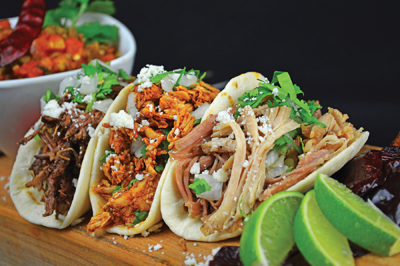 |
Prudential Center’s Angry Taco is part of the trend toward more freshly prepared food.
Photo by: Legends Hospitality |
■ KLINE: Everyone is focused on providing the highest and most efficient guest experience. It can no longer be only about the food or beverage but also how it’s delivered and when. Investment continues to improve the look and feel of food and beverage choices but also the infrastructure and footprint to deliver an entire and efficient experience.
■ FERRULO: When you think about how many times fans interact with our crews, there’s no doubt that we are representing the brand as well as the city. For that reason, we actually encourage clients to think of us as their hospitality partner. Overall, I think there’s a real sophistication on the part of owners and authorities to think outside of game day, so we’re investing much more in social events, and building an infrastructure for entertainment (as opposed to a single-purpose building).
■ ADAMS: A strong trend toward using capital investments to increase technology throughout facilities, not just that which is focused on [food and beverage] operations. Also more of a trend in space improvements, facades and updates, and less so on improving menu selections.
■ SMITH: Capital investments must be utilized on projects that enhance the guest experience. When this happens, all of the stakeholders win. The fans have a better experience and are willing to spend more money. The teams often use the enhanced amenities as a way to keep the fans connected to the brand, and the hospitality business usually sees a lift in per capita spending, which is outside of price increases.
■ FAULKNER: Partners are looking for smarter, insight-driven concepts that bring a full range of innovations to drive business in multiple areas. We use the offseasons to test new concepts and technology that allow us to learn more about fans’ preferences in near real-time, with the ability to make adjustments in service and offerings on the fly.
■ BIGELOW: Not much has changed over the years as far as the deals. There will always be long-term, high-investment deals out there for concessionaires, and there will always be venues realizing they prefer short-term, lower-investment arrangements.



